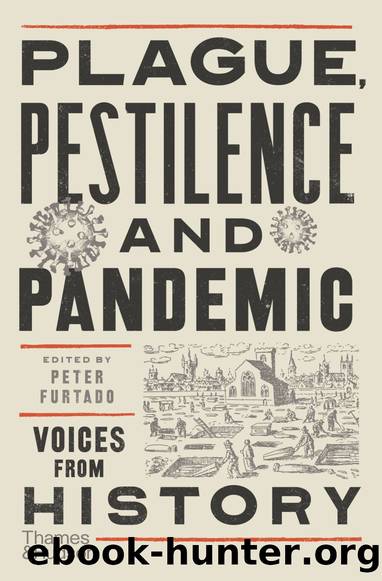Plague, Pestilence, and Pandemic: Voices From History by Peter Furtado

Author:Peter Furtado [Furtado, Peter]
Language: eng
Format: epub
ISBN: 9780500776476
Google: rH4rEAAAQBAJ
Amazon: 0500296138
Barnesnoble: 0500296138
Goodreads: 55678395
Publisher: Thames & Hudson
Published: 2021-03-15T00:00:00+00:00
TYPHUS AND TYPHOID FEVER
For much of history, these two diseases â which have similar symptoms, notably a high fever accompanied by a rash of small red spots â were taken to be different forms of the same disease, named from the Greek word typhos (âsmokeâ or âhazeâ), the term used by Hippocrates to describe the mental confusion caused by high fevers. They both flourished in crowded and insanitary conditions, and were found among the urban poor in 19th- century Europe and America. However, in the 1830s it became clear that they were quite different: typhus is caused by the Rickettsia prowazekii bacterium carried by lice, whereas typhoid fever is a Salmonella infection of the gut, transmitted in water contaminated by human faeces.
Both diseases caused serious epidemics in the 18th and 19th centuries; typhoid remains endemic in many poor countries and is still a threat in emergency situations where sanitation is disrupted.
Distinguishing typhus from typhoid
WILLIAM WOOD GERHARD, âOn the Typhus Feverâ (1837)
The Philadelphian doctor William Wood Gerhard (1809â1872) studied in Paris where he made a particular study of communicable diseases. He was present at the typhus epidemic that broke out in his native city in 1836, and his careful study of its symptoms allowed him to demonstrate for the first time that it was a distinct disease from typhoid.
During a residence of two or three years at Paris, I had studied with great care the pathology and treatment of the disease usually termed, in the French hospitals, typhoid fever. There is another designation for it, more directly in accordance with modern medical nomenclature; it is dothinenteritis. This variety of feverâ¦is almost the only fever which can be said to be endemic in Paris.⦠It is one of the most frequent and the most severe acute affections observed at Paris, and has been studied with extreme accuracy. The work of Dr Louis is a model in its kind; he has analyzed the symptoms and pathological phenomena of the fever so accurately and fully, as to surpass any other description of individual diseases.
It affords us, then, great advantages in the investigation of the history of fevers, to begin with the typhoid, as the best known of these affections. Assuming this disease as the basis of our investigations, much greater certainty can be given to our ulterior researches, if we compare the symptoms of any fever which is little known and imperfectly described, with those of the typhoid fever.
This inquiry was in accordance with a desire which I had long cherished of investigating the most common fevers in the middle states of America, where, from our geographical position, we witness the fevers observed at the northern, and occasionally those of the southern states. The commercial relations of Philadelphia are so frequent with the whole southern coast of the United States, and the passage to the north so rapid in the summer and autumnal months, that we receive into our hospitals a considerable number of patients taken ill on the coast of North Carolina, Virginia, and even Alabama and Louisiana.
Download
This site does not store any files on its server. We only index and link to content provided by other sites. Please contact the content providers to delete copyright contents if any and email us, we'll remove relevant links or contents immediately.
| Archaeology | Essays |
| Historical Geography | Historical Maps |
| Historiography | Reference |
| Study & Teaching |
Underground: A Human History of the Worlds Beneath Our Feet by Will Hunt(12024)
Sapiens by Yuval Noah Harari(5294)
Navigation and Map Reading by K Andrew(5111)
The Sympathizer by Viet Thanh Nguyen(4305)
Barron's AP Biology by Goldberg M.S. Deborah T(4099)
5 Steps to a 5 AP U.S. History, 2010-2011 Edition (5 Steps to a 5 on the Advanced Placement Examinations Series) by Armstrong Stephen(3689)
Three Women by Lisa Taddeo(3354)
Water by Ian Miller(3128)
The Comedians: Drunks, Thieves, Scoundrels, and the History of American Comedy by Nesteroff Kliph(3039)
Drugs Unlimited by Mike Power(2545)
A Short History of Drunkenness by Forsyth Mark(2233)
DarkMarket by Misha Glenny(2159)
The House of Government by Slezkine Yuri(2159)
And the Band Played On by Randy Shilts(2129)
The Library Book by Susan Orlean(2042)
Revived (Cat Patrick) by Cat Patrick(1963)
The Woman Who Smashed Codes by Jason Fagone(1929)
Birth by Tina Cassidy(1864)
The Absolutely True Diary of a Part-Time Indian by Sherman Alexie(1859)
